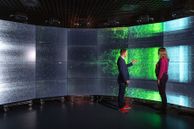Research Strategy & Impact
The Department has four overarching collaborative themes through which new research directions are driven. We are structured into nine research groups: Astrophysics (ASTR), Condensed Matter Theory (CMTH), Experimental Solid State Physics (EXSS), High Energy Physics (HEPH), Plasma Physics (PLAS), Photonics (PHOT), Quantum Optics & Laser Science (QOLS), Space & Atmospheric Physics (SPAT), and Theoretical Physics (THEO). Research is not siloed in these formal groups and staff are encouraged to collaborate and interact via the themes. Staff associate with multiple themes, providing the flexibility needed to tackle multidisciplinary challenges.
This flexible and nimble thematic approach has created vibrant collaborations and new research directions, e.g. combined laboratory fusion plasma modelling with planetary magnetospheres, to enable space weather prediction (SPAT, PLAS); Quantum Technology and Quantum Information Science (QOLS, CMTH, EXSS with participation in the Strategic Advisory Board (Knight-Chair) and three UK Hubs with leadership from Kim(M), Hinds, Walmsley); generated activities in Fundamental Physics such as cosmology (ASTR, THEO), dark matter (ASTR, HEPH), phenomenology (HEPH, THEO) and emerging activities in advanced statistics, AI and machine learning (all groups). Space Plasma & Climate provides a natural forum for our work on exoplanets (ASTR, SPAT) and in Condensed Matter Physics techniques are brought together from metamaterials and nanophotonics (EXSS, CMTH).
To find out more, please check out the Imperial Physics' REF2021 Environment Statement.
Our research strategy is based on solid pillars:
Carousel widget

Pursue Innovation
To tackle world's challenges

Interlaboratory Collaborations
To facilitate an interdisciplinary approach to research

State-of-the-art Facilities
To carry out world-changing research

Captivating Talks
To sensitise the public towards physical sciences

Inclusive Environment
Where everyone can reach their full potential
Impact Case Studies
Impact Case Studies
To know more about our Impact cases at Imperial Physics, please visit our REF2021 impact case study database. This function allows you to browse and search for impact case studies submitted to the REF 2021. Use the search and filters to find the impact case studies you are looking for.


